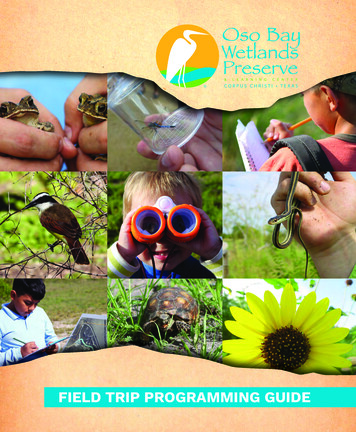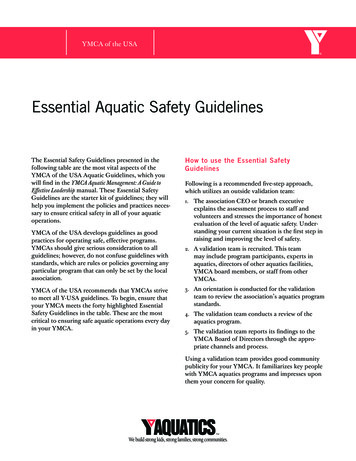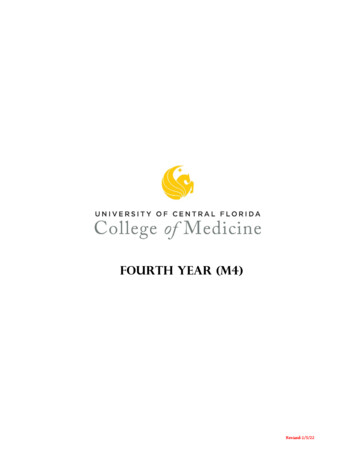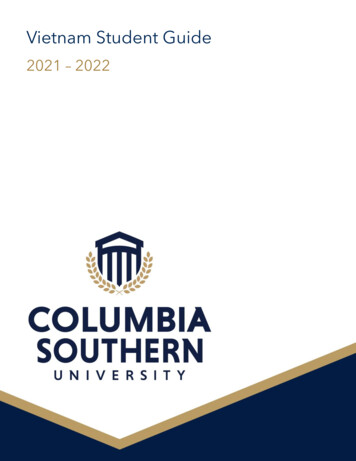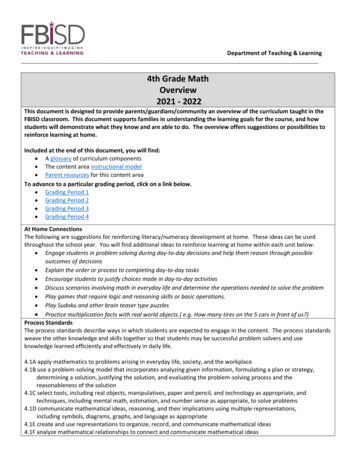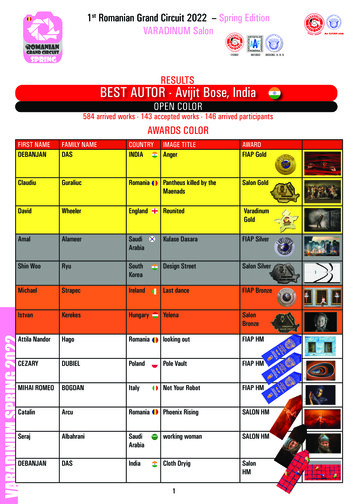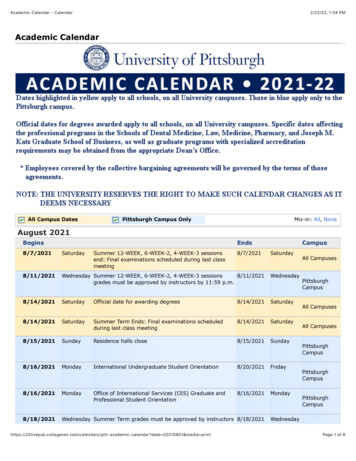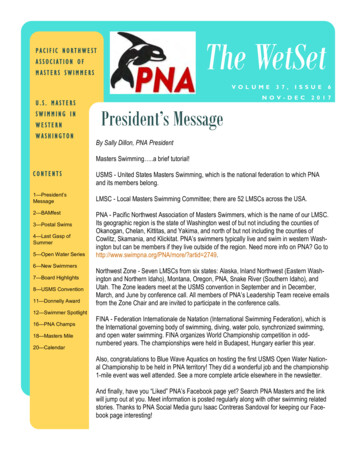
Transcription
Department of Teaching & LearningAquatic ScienceOverview2021 - 2022This document is designed to provide parents/guardians/community an overview of the curriculum taught in theFBISD classroom. This document supports families in understanding the learning goals for the course, and howstudents will demonstrate what they know and are able to do. The overview offers suggestions or possibilities toreinforce learning at home.Included at the end of this document, you will find: A glossary of curriculum components The content area instructional model Parent resources for this content areaTo advance to a particular grading period, click on a link below. Grading Period 1 Grading Period 2 Grading Period 3 Grading Period 4Process StandardsThe process standards describe ways in which students are expected to engage in the content. The process standardsweave the other knowledge and skills together so that students may be successful problem solvers and useknowledge learned efficiently and effectively in daily life.1(A) demonstrate safe practices during laboratory and field investigations, including chemical, electrical, and firesafety, and safe handling of live and preserved organisms; and1(B) demonstrate an understanding of the use and conservation of resources and the proper disposal or recycling ofmaterials.2(A) know the definition of science and understand that it has limitations, as specified in subsection (b)(2) ofthis section;2(B) know that scientific hypotheses are tentative and testable statements that must be capable ofbeing supported or not supported by observational evidence. Hypotheses of durable explanatory power which havebeen tested over a wide variety of conditions are incorporated into theories;2(C) know that scientific theories are based on natural and physical phenomena and are capable of being tested bymultiple independent researchers. Unlike hypotheses, scientific theories are well-established and highlyreliable explanations, but they may be subject to change as new areas of science and new technologiesare developed;2(D) distinguish between scientific hypotheses and scientific theories;2(E) plan and implement investigative procedures, including asking questions, formulating testable hypotheses, andselecting, handling, and maintaining appropriate equipment and technology;2(F) collect data individually or collaboratively, make measurements with precision and accuracy, record values usingappropriate units, and calculate statistically relevant quantities to describe data, including mean, median, and range;2(G) demonstrate the use of course apparatuses, equipment, techniques, and procedures;2(H) organize, analyze, evaluate, build models, make inferences, and predict trends from data;2(I) perform calculations using dimensional analysis, significant digits, and scientific notation; and
Department of Teaching & Learning2(J) communicate valid conclusions using essential vocabulary and multiple modes of expression such as lab reports,labeled drawings, graphic organizers, journals, summaries, oral reports, and technology-based reports.3(A) in all fields of science, analyze, evaluate, and critique scientific explanations by using empirical evidence, logicalreasoning, and experimental and observational testing, including examining all sides of scientific evidence of thosescientific explanations, so as to encourage critical thinking by the student;3(B) communicate and apply scientific information extracted from various sources such as current events, newsreports, published journal articles, and marketing materials;3(C) draw inferences based on data related to promotional materials for products and services;3(D) evaluate the impact of research and technology on scientific thought, society, and the environment;3(E) describe the connection between aquatic science and future careers; and3(F) research and describe the history of aquatic science and contributions of scientists.Grading Period 1Unit 1: Introduction to Aquatic ScienceEstimated Date Range: August 11 – August 30Estimated Time Frame: 14 daysUnit Overview: In this unit the student will learn and demonstrate knowledge of safety responsibilities in the aquaticsclassroom. Students will learn how to create a sustainable aquatic ecosystem in an aquarium, and will build their ecosystem. Thisunit will also provide a history of aquatic science and introduce the students to the study of oceanography and marine biology.At home connections:Discuss general lab safety and the importance of being safe.Concepts within Unit #1Success Criteria for this conceptLink to TEA High School Science TEKSConcept #1: Safety list/describe all of the general safety rules regarding conduct, clothing,1A, 1Baccidents, glassware, heating/fire, animals, etc Concept #2: Introduction to AquaticScience2F, 2J, 2H, 3A follow all the safety rules of the time during laboratory/fieldinvestigations.identify the safety equipment in the classroom.explain how and when to use the safety equipment in the classroom.explain the procedures for an injury.explain the procedures for broken glass/equipment.Explain the proper time and dosage amount of chemical to add to theamount of water in the aquariumCalculate the dose of chemical required based on the gallons of water inthe aquariumDiagnose a chemical imbalance using water test kitIdentify the necessary parts of an aquarium and describe their functionSet up a functioning aquarium (salt or freshwater) with fish and justifychoice based on data
Department of Teaching & Learning Explain how fish compatibility impacts the aquarium ecosystemUnit 2: Water Chemistry and PropertiesEstimated Date Range: August 31 – September 14Estimated Time Frame: 10 daysUnit Overview: In this unit, students will use appropriate tools to measure water chemistry in order to determine the health ofan ecosystem. Students will explore how water chemistry and water properties affect aquatic ecosystems. Students will have theopportunity to apply their knowledge of water chemistry and water properties to their tank ecosystem.At home connections: Look up or request a water quality report from your local water company.Success Criteria for this conceptConcepts within Unit # 2Link to TEA High School Science TEKSConcept #1: Water Chemistry and Be able to explain what change in the tank may have caused there to be aPropertieschange in the water quality of the tank using qualitative and quantitative data4A, 2H, 5B,8A Explain how chemical and physical properties of water aid in the survival ofaquatic organisms Determine the quality of water in an aquarium by testing the following:o Nitrateo Nitriteo PHo Temperatureo ammonia Observe the effect salinity has on an organism by conducting an osmosis labUnit 3: Aquatic CyclesEstimated Date Range: September 15 – October 6Estimated Time Frame: 15 daysUnit Overview: In this unit, students will explore how the biogeochemical cycles (water cycle, phosphorous cycle, carbon cycle,and the nitrogen cycle) affect the aquatic environment. Student will analyze water quality data using their aquariums to evaluatethe proper cycling of nutrients and elements within the ecosystem. Students will also explore how humans have impacted thecycling of nutrients in the aquatic ecosystem.At home connections: Discuss how the water cycle happens in and around your home. If you can visit a lake or pond, discuss thebiogeochemical cycles as they happen there.Concepts within Unit # 3Link to TEA High School Science TEKSConcept #1: Aquatic Cycles4A, 5A, 2F, 2HSuccess Criteria for this concept Collect data from tanks and use systems thinking to predict what would happento the tank if changes in feeding and lighting occur
Department of Teaching & LearningCompare how natural seasonal change in an aquatic environment affectorganisms differently than how an unusual change in an aquatic environmentaffect organisms using evidence Compare how natural seasonal change in an aquatic environment affectorganisms differently than how an unpredictable change (human caused ornatural) in an aquatic environment affect organisms using evidence.Unit 4: Water Dynamics Collect data from tanks and use systems thinking to predict what would happenEstimated Date Range: October 12 – November 2to the tank if changes in feeding and lighting occurEstimated Time Frame: 15 days Explain how an imbalance in one part of the nutrient cycle can affect other partscarbon,phosphorus,water)Unit Overview: In this unit, students will explore(nitrogen,the availabilityof waterresources,and evaluate the impact of the movement Comparehownaturalseasonalchangeaquatic environmentaffect theof water on the geography of an area. Waves and tides will be examined to connecthow intheanmovementof water nanaquaticenvironmentliving and nonliving components of an aquatic ecosystem. This unit will also explore how humans impact aquatic ecosystems andaffect organismsusingthe natural geography of the coast. Finally, the studentswill evaluatetheevidenceeffectiveness of the Clean Water Act and how we can Grading Period 2continue to conserve our aquatic resources.At home connections: Research any local attempt to protect water resources in your area. Identify human impacts to water quality in your neighborhood or region.Concepts within Unit # 4Success Criteria for this conceptLink to TEA High School Science TEKSConcept #1: Movement of Water Using evidence, determine if the Clean Water Act supports or refutes solving8A, 8B, 12E, 7A, 7B, 7C, 12Awater resource problems Communicate the cause and effects of water resource problems as well asprovide solutions for these problems Use systems thinking and data analysis to describe the relationship betweenhuman impact on a water resource and the aquatic organisms Explain how positive and negative feedback cycles play in the lack or abundanceof water Communicate the cause and effects of water resource problems as well asprovide solutions for these problems Use systems thinking and data analysis to describe the relationship betweenhuman impact on a water resource and the aquatic organisms Using evidence, determine if the Clean Water Act supports or refutes solvingwater resource problemsUnit 5: Meteorology and GeologyEstimated Date Range: November 3 – November 16Estimated Time Frame: 10 daysUnit Overview: In this unit, students will explore how weather and climate are related to aquatic systems. Students will explorehow geological features and ocean currents affect the distribution of aquatic organisms. Students will also use data to exploreand analyze hurricane patterns.At home connections: Watch weather forecasts together. Discuss how your local weather may affect various organisms.Concepts within Unit # 5Link to TEA High School Science TEKSSuccess Criteria for this concept
Department of Teaching & LearningConcept #1: Meteorology and Geology Explain how a change in atmospheric conditions will cause a change inoceanic conditions dictating the distribution of the organisms in theoceanPredict how ocean currents and geological activity dictate organismdistribution in the oceanUse data and evidence to explain how hurricane frequency and intensityare related to climate changeUnit 6: Aquatic EcologyEstimated Date Range: November 17 – December 17Estimated Time Frame: 18 daysUnit Overview: In this unit, students will examine how energy flows within an aquatic ecosystem, and explore how thebiotic and abiotic factors in an aquatic ecosystem are interrelated.At home connections: Identify biotic and abiotic factors in your neighborhood. Discuss differences between the biotic and abiotic factors thatwould be in an aquatic ecosystem compared to your neighborhood.Concepts within Unit # 6Link to TEA High School Science TEKSConcept #1: Aquatic Ecology10B, 11A, 2H, 5C, 5D, 9A, 9C, 10C, 11BSuccess Criteria for this concept Investigate why some organisms have more advantageous adaptations thanother organismsCompare and contrast how energy flows within a fresh water system versus asalt water systemUse data to describe and explain how some adaptations would be favorable inone ecosystem but not another ecosystem.Use qualitative data to explain how the ecosystem affects the adaptations thatorganisms have.Grading Period 3Unit 7: Aquatic EcosystemsEstimated Date Range: January 5 – February 1Estimated Time Frame: 19 daysUnit Overview: In this unit, students will explore the biotic and abiotic factors of Freshwater and Marine Ecosystems, and theirinfluence on the organisms living in the ecosystems. Students will investigate symbiotic relationships, explore the importance ofeach ecosystem, and investigate environmental issue affecting freshwater and marine ecosystems.At home connections: Research environmental issues that are affecting freshwater and marine ecosystems. Discuss these environmental issueswith your child and what impact they may have on those ecosystems.Concepts within Unit # 7Success Criteria for this concept
Department of Teaching & LearningLink to TEA High School Science TEKSConcept #1: Aquatic Ecosystems9C, 10B, 5A, 8C, 9A, 9C, 10A, 10C Explain how biological, chemical, physical, and geological properties of afreshwater ecosystem affects the freshwater organism adaptationsExplain how the biological, chemical, physical, and geological propertiesof the Tropical Marine systems affect organisms that live in TropicalMarine EcosystemsExplain how lake succession affects organism population anddistributionCompare and contrast the adaptations of lotic organism to lenticorganisms
Department of Teaching & LearningUnit 8: Coastal and Wetland EcosystemsEstimated Date Range: February 2 - February 17Estimated Time Frame: 12 daysUnit Overview: In this unit, students will explore the differences between and different types of Coastlands and Wetlands.Students will explore the biotic and abiotic factors of these ecosystems and investigate how the biotic and abiotic factors affectthe organisms living in these ecosystems. Students learn about the importance of Coastlands and Wetlands and investigateenvironmental issues these ecosystems experience.At home connections: Research environmental issues that are affecting coastal wetland ecosystems. Discuss these environmental issues withyour child and what impact they may have on those ecosystems.Concepts within Unit # 8Link to TEA High School Science TEKSConcept #1: Coastal andWetland Ecosystems9C, 10B, 5A, 8C, 9A, 9C, 10A, 10CSuccess Criteria for this concept Compare and contrast rocky intertidal, sandy intertidal, mudflats,mangroves, and salt marsh ecosystems and organismExplain how the biological, chemical, physical, and geological propertiesof the Coastal and Wetland systems affect organisms that live in theCoastal and Wetland ecosystems.Explain the causes and effects of environmental issues that are plaguingcoastlands and wetlandsUnit 9: Temperate Marine EcosystemsEstimated Date Range: February 22 – March 11Estimated Time Frame: 14 daysUnit Overview: In this unit, students will explore the abiotic and biotic factors of the different Temperate Marine Ecosystems,and how they influence the organisms who live in the ecosystem. Students will investigate kelp forests, the open ocean, and thedeep sea and explore the differences in the food webs in each ecosystem. Students will also investigate the importanceof Temperate Marine Ecosystems and the environmental issues that impact them.At home connections: Research environmental issues that are affecting temperate marine ecosystems. Discuss these environmental issues withyour child and what impact they may have on those ecosystems.Concepts within Unit # 9Link to TEA High School Science TEKSTemperate Marine EcosystemsSuccess Criteria for this concept 9C, 10B, 5A, 8C, 9A, 9C, 10A, 10C Describe how the environment of the kelp forest, open ocean, anddeep sea affect the adaptations of the different organisms that livethereDescribe how dogfish adaptations make them successful in theirecosystemExplain how energy is obtained differently by organisms at the surfacecompared to those in the deep seaExplain how regulations and laws help to keep the oceans healthyExplain how kelp is used in our everyday lives
Department of Teaching & Learning
Department of Teaching & LearningGrading Period 4Unit 10: Tropical Marine EcosystemsEstimated Date Range: March 21 – April 6Estimated Time Frame: 13 daysUnit Overview: In this unit, students will explore the biotic and abiotic factors of Freshwater and Marine Ecosystems, and theirinfluence on the organisms living in the ecosystems. Students will investigate symbiotic relationships, explore the importance ofeach ecosystem, and investigate environmental issue affecting freshwater and marine ecosystems.At home connections: Research environmental issues that are affecting tropical marine ecosystems. Discuss these environmental issues withyour child and what impact they may have on those ecosystems.Concepts within Unit # 10Link to TEA High School Science TEKSConcept #1: Tropical Marine Ecosystems9C, 10B, 5A, 8C, 9A, 9C, 10A, 10CSuccess Criteria for this concept Explain how ocean acidification affects the coral reefsExplain how an increase in temperature affects the coral reefsDraw and describe the structure of a coral reefExplain adaptations that are specific to the coral reefsCommunicate the state of the coral reef and predict whether they canrecoverUnit 11: Polar Marine SystemsEstimated Date Range: April 7 – April 28Estimated Time Frame: 14 daysUnit Overview: In this unit, students will explore the biotic and abiotic factors and their influence on Polar MarineEcosystems. Students will investigate the similarities and differences between the Arctic area and Antarctica. Students will alsoinvestigate the many environmental issues impacting Polar Marine Ecosystems, and the causes and effects of Climate Change onthe ecosystem.At home connections: Research environmental issues that are affecting polar marine ecosystems. Discuss these environmental issues with yourchild and what impact they may have on those ecosystems.Concepts within Unit # 11Link to TEA High School Science TEKSConcept #1: Polar Marine Ecosystems9C, 10B, 5A, 12A, 12DSuccess Criteria for this concept Describe the adaptations needed for organisms to be able to survive the coldof the Arctic and the AntarcticExplain the difference between the Arctic and the AntarcticDescribe how seasons in the Antarctic will dictate the abundancy of lifeExplain how climate change will affect the Polar Marine EcosystemsExplain the effects of a melting Arctic versus a melting Antarctic
Department of Teaching & LearningUnit 12: Human ImpactEstimated Date Range: April 29 – May 26Estimated Time Frame: 20 daysUnit Overview: In this unit, students will explore the major issues that affect aquatic environments, the human benefits, and thedetriments to the environment. Students will research current environmental protections and improvements that need to bemade.At home connections: Research current environmental protections and any improvements that need to be made in order for humans to haveminimal negative impact to the environment. Make a list of what students can do to protect aquatic environments.Concepts within Unit # 12Link to TEA High School Science TEKSConcept #1: Human Impact12A, 12E, 12B, 12C, 12DSuccess Criteria for this concept Explain how humans impact aquatic ecosystems (positive/negative) andprovide possible solutionsDesign and carry out a citizen science project about a real worldsituation/problemPresent the results of my project to class in a scientific way both orally andwrittenPresent myself in a professional manner when I communicate my resultsEngage in scientific argumentation using proper protocols
Department of Teaching & Learning
Department of Teaching & LearningGlossary of Curriculum ComponentsOverview– The content in this document provides an overview of the pacing and concepts covered in a subject for theyear.TEKS – Texas Essential Knowledge and Skills (TEKS) are the state standards for what students should know and be ableto do.Unit Overview – The unit overview provides a brief description of the concepts covered in each unit.Concept – A subtopic of the main topic of the unit.Success Criteria—a description of what it looks like to be successful in this concept.Parent ResourcesThe following resources provide parents with ideas to support students’ understanding. For sites that are passwordprotected, your child will receive login information through their 908Discovery Education ResourcesKhan AcademyTexas GatewaysNSTA – Science Resources for ParentsNOAA – National Oceanic and AtmosphericAdministrationHow it supports parent and studentsThis is the state adopted textbook for Aquatic Science. Click onthe link for directions on accessing the textbook.This online resource provides access to a wide variety of videosto help in learning more about science concepts.This resource contains practice exercises, instructional videos,and a personalized learning dashboard where students canlearn and study at their own pace.This online resource contains lessons, videos, and interactiveactivities for various science concepts.This online resource has science activities for high schoolstudents and their families to help support learning at home.This resource is contains videos, images, interactive media,graphics and data related to the ocean and atmosphere.
Department of Teaching & LearningInstructional ModelThe structures, guidelines or model in which students engage in a particular content that ensures understanding ofthat content. It is based on the constructivist learning theory, which states that learners build or construct new ideas basedon their experiences.It represents a recursive cycle of cognitive stages in inquiry-based learning.Stages are intended to be completed sequentially; however, you may revisit a stage more than once duringthe 5E process.It capitalizes on hands-on activities, students’ curiosity, and academic discussion among students.Typically, NOT all five stages would be experienced in a single classroom period, but all five would certainly beembedded in a series of lessons that would develop a particular concept, lasting days or weeks.It should be used to develop conceptual understanding over time with each stage building on the previousstage, rather than serve as a series of activities.It should be used in conjunction with other instructional strategies such as writing in science, graphing,graphic organizers, collaboration, etc.
Aquatic Science Overview 2021 - 2022 This document is designed to provide parents/guardians/community an overview of the curriculum taught in the FBISD classroom. This document supports families in understanding the learning goals for the course, and how stu

